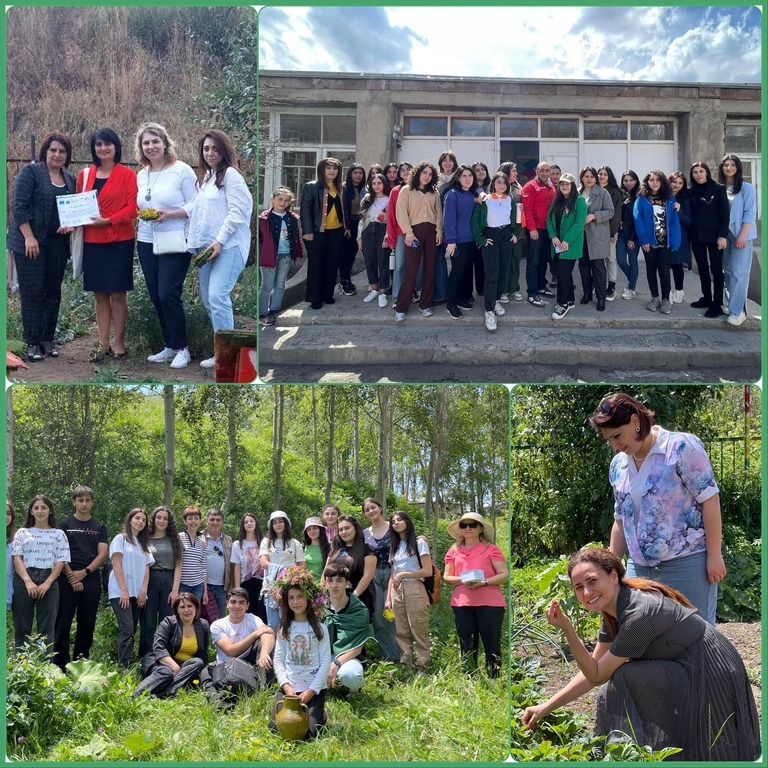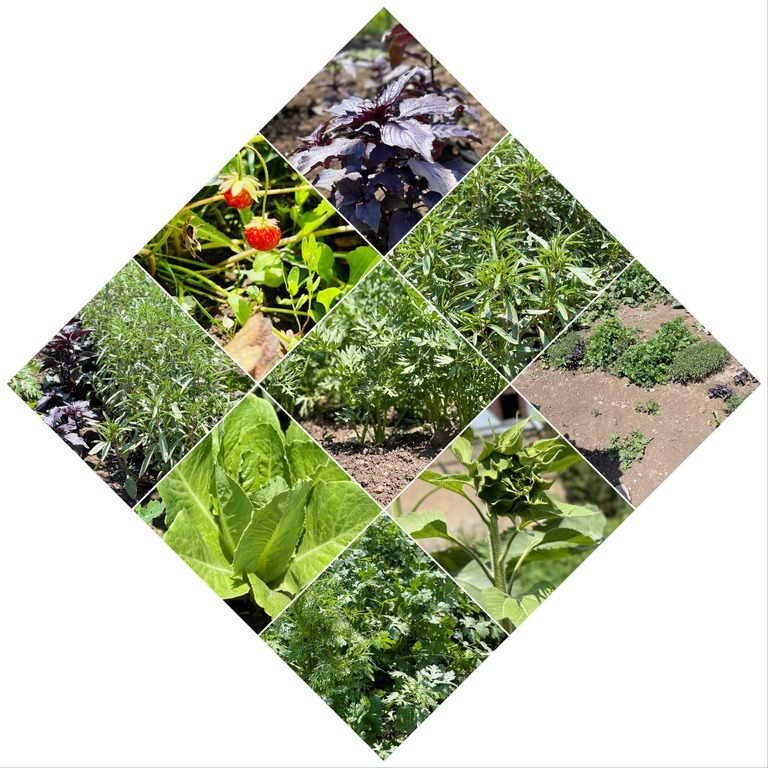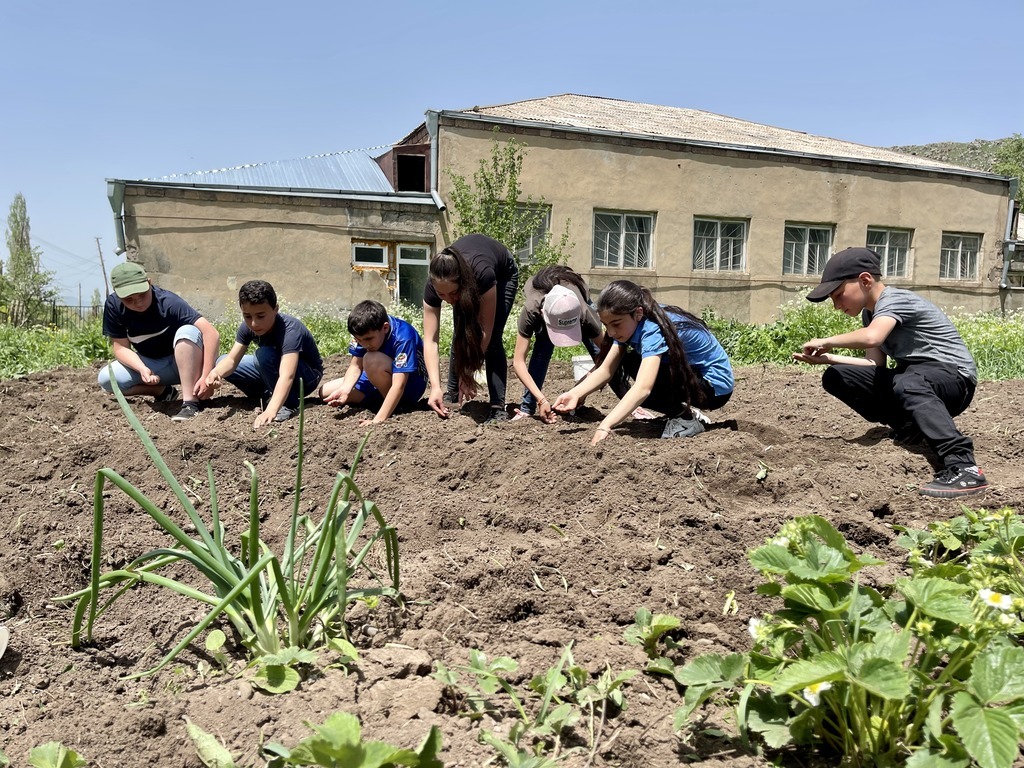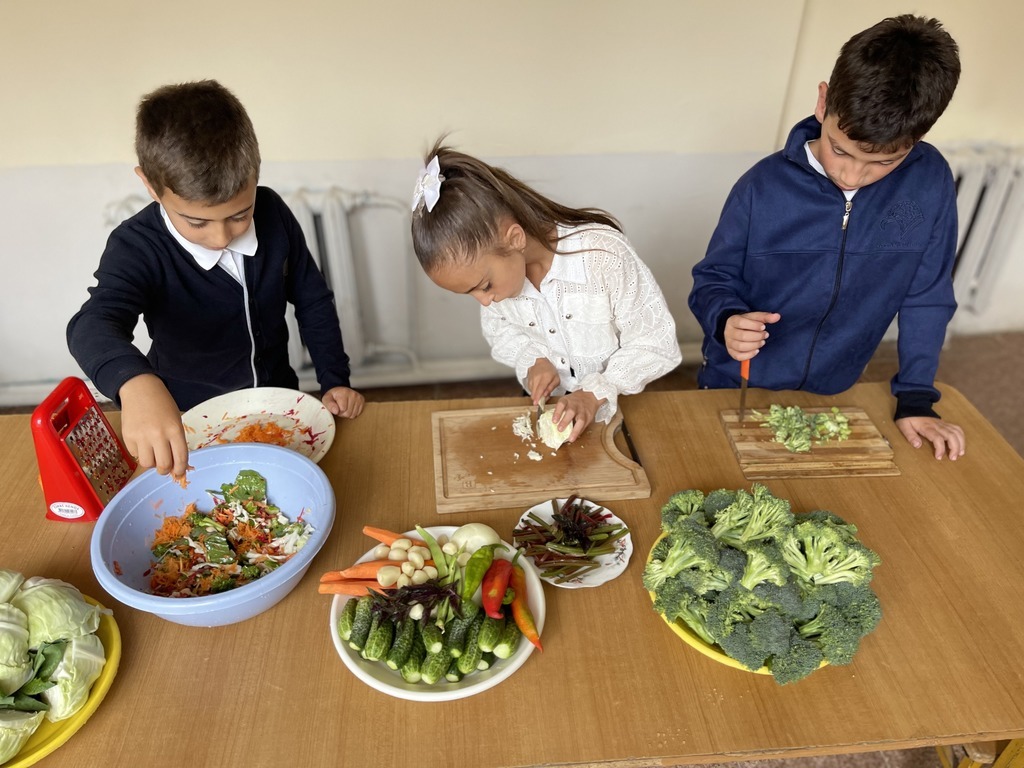“We invite the readers to our children’s beloved garden, the door to which is always
open for guests. This garden gifts every visitor the warmth and kindness of the sun”
Gegharkunik community school
For two straight years, Gegharkunik community school participated in the Best School Mini Garden competition held as part of the National School Feeding Programme. In 2021, the school won the ‘Best Crops’ nomination while in 2022 it was recognized as the outright winner.
What does the Best School Mini Garden look like?
Having learned about the competition for the first time, the school decided to establish a small vegetable garden on a small territory of 50sq.m. adjacent to its apple garden. Teachers, parents, children, and just kind-hearted people joined efforts towards a common goal. As a result, the school was named the winner of the ‘Best Crops’ nomination.
“Why was it so special? Because we invested a huge deal of effort, energy, love, and care in a small plot of land that gave back with splendid gifts. We actually did not expect this uncultivated land to yield the best crops: rich, delicious, healthy, and ecologically clean.”
Inspired by the previous year’s success and armed with new ideas, the school enlarged the vegetable garden up to 60sq.m., worked hard, and reached an awesome result, winning first place honors.

Special concept
This year, all participants in the competition had to follow the concept of organic farming. In their projects, the schools elaborated upon every component of the process of growing organic products: seed, oxygen, light and warmth, water, carbon dioxide, macro- and micronutrients, soil acidity, soil enrichment with microorganisms, strong immunity, and rich harvest as a result.
As well as following the “green” principles, the Gegharkunik community school came up with a special concept.
“We were inspired by the queen of Gegham Mountains, the three-headed Azhdahak Mountain. The planting was done in the form of the mountain and of the raising sun. In the central part of the garden, we planted sunflowers.”
How we maintained the garden
Sunlight and warmth are the guarantors of a rich and high-quality harvest. That’s why the vegetable garden was established in a sunny area, where the plants were supposed to grow from the smallest to the bigger ones so that all of them get enough sunlight and warmth.
With the help of a special device - a pH meter - the acidity of the soil was checked and classified as neutral (pH 6.34), which is the most favorable index for a superb garden because in this case, the soil has a rich sediment layer.

When selecting the crops, the school gave preference to endemic plants that could be further used in the preparation of school meals: potatoes, pumpkins, cabbage, broccoli, carrots, white and red beet, green bell pepper, beans, peas, strawberries, radish, sunflowers, and herbs: parsley, basil, and fennel.

Before planting, the seeds were left in the sun for a while for natural disinfection and then soaked in water.
To provide the plant with the necessary amount of carbon dioxide, the gardeners planted pulses that are rich in nitrogen-fixing bacteria capable of transforming atmospheric nitrogen into fixed nitrogen (inorganic compounds usable by plants).

Fertile soil is always oxygenated. This was ensured in three ways. The soil was plowed in autumn and spring prior to the sowing. It was cleared of stones and weeds. In addition, soil aeration was performed for better gas exchange and earthworms were put into the soil. As it’s known, earthworms offer many benefits: increased nutrient availability, better drainage, and a more stable soil structure, all of which help improve farm productivity.
The garden was regularly irrigated in sunny and dry weather to provide the soil with the necessary amount of water for seed germination. Later, the sprouts were irrigated in the evening to prevent evaporation and let the water make its way to the roots of the plants.
While working in the garden, the children studied the colors and shapes of the leaves and concluded that the plants growing in their garden were rich in minerals and have strong immunity.
“Plants are like people. They have an immune system that becomes stronger thanks to sunlight, warmth, oxygen, and, of course, uninterrupted care and love. All these components were secured by our children, teachers, parents, and community members. We plowed the soil, cleared it of weeds, and made it softer. We treated the plants as living beings. We organized outdoor lessons to arm the kids with new knowledge and valuable experience.”
In autumn, after the harvest, the remaining leaves and roots were earthed to rot in the superficial and deep layers of the soil, enriching it with organic compost that serves as an additional source of warmth for the plants and microorganisms essential for soil fertility.
You reap what you sow
The result of joint efforts was not long in waiting: the competition participants enjoyed an ecologically clean and bountiful harvest. Children, parents, and teachers, as well as the members of the ‘1+1’ school newspaper and Azhdahak eco-club, harvested the crops. During the harvest, responsibilities were evenly distributed. The primary school children picked the crops, children from grades 5 to 9 sorted them out, while high school students carried the products to the storehouse. The parents spaded the soil while the teachers collected leaves and roots to earth them in a post-harvest period and get organic compost in spring.

A part of the vegetables was stored to be used in winter and the other part was kept for seeds. Parents and high school students pickled some vegetables while the juniors made salads with broccoli, cabbage, lettuce, and carrots. The beet tops were cooked as a separate dish everyone relished.

Lessons in the garden
For the children, the whole process was by no means dull and heavy work. It was an exciting journey into the world of organic farming that offered new knowledge and skills. Indeed, what can be better than lessons under the open sky and without textbooks?
The children learned how to take care of plants, how to cultivate the soil after harvesting and prepare it for the next year’s sowing, how to sort out the crops, lay a store of vegetables for winter, or keep them for seeds.
The work in the school garden has turned out as an exciting outdoor adventure. High school students staged an educational performance titled “Our garden turns dreams into reality” while the children of grades 3 and 4 acted as heroes of the famous fairytale “The Turnip.” They pulled the biggest turnip out of the soil and animated it by sticking eyes, nose, and mouth to it.

The knowledge the children acquired in the garden was cemented in a very special way: an interactive board was placed in the primary school lobby and after each lesson in the garden, working with the plants, or harvesting, the children approached the board and made relevant notes.

One of the methods selected by the school to help the children digest the information was the ‘Know - Want to Know - Have Learned’ technique which determines the level of children’s knowledge and reveals the gaps. It can also be used for tracking and analyzing academic progress. The game also teaches children to work as a team and develop soft skills. The interactive board deservingly became one of the children’s favorite spots at school.
“Maintaining the garden has become a new and nonstandard educational methodology, where one short phrase ‘mini garden’ comes to substitute hundreds of words. Everything around is filled with innocent children’s laughter that radiates light and warmth. Just look at the forget-me-nots that the kids drew on the fence, the nest they made for sparrows, and the national flags they put on the walls. Indeed, it was no accident that we have chosen Azhdahak Mountain as the source of inspiration for our garden. It filled us with energy and as a result, we are now a team of dedicated and strong people - the schoolchildren and their parents, representatives of the local administration, the ‘1+1’ school newspaper, the Azhdahak eco-club, and numerous guests, who bring us love and care.”

